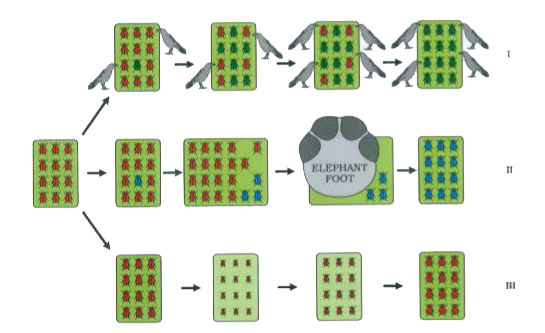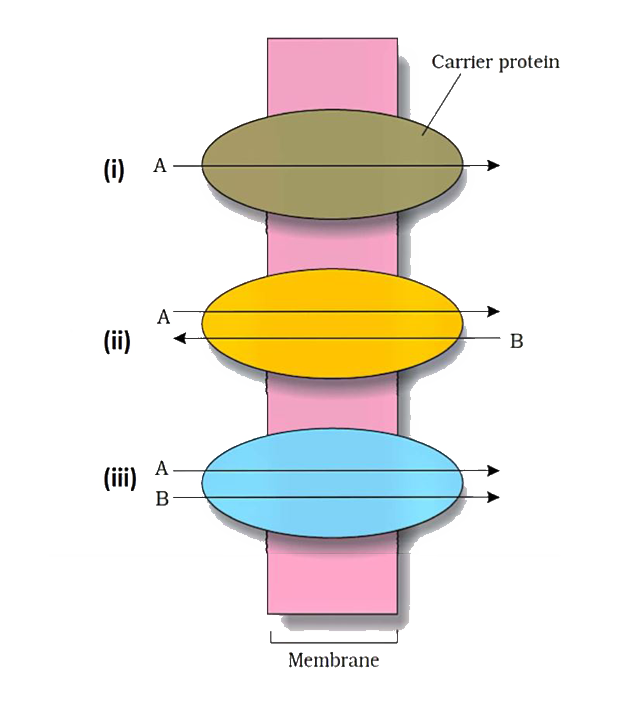
From the diagram, state the result in case I, II and III.Solution in Gujrati
The correct Answer is:I. It is a case of natural selection of green beetle population.
II. It is a case of genetic drift which provides diversity without any adaptations.
III. It is a case of acquired trait of low weight beetles due to starvation.
Step by step video, text & image solution for From the diagram, state the result in case I, II and III. by Biology experts to help you in doubts & scoring excellent marks in Class 10 exams.
Updated on:21/07/2023Topper's Solved these Questions
- HEREDITY AND EVOLUTIONBOOK - KUMAR PRAKASHANCHAPTER - HEREDITY AND EVOLUTIONEXERCISE - OBJECTIVE QUESTIONS AND ANSWERS (Answer the following questions in short : )
1 Video
- HEREDITY AND EVOLUTIONBOOK - KUMAR PRAKASHANCHAPTER - HEREDITY AND EVOLUTIONEXERCISE - OBJECTIVE QUESTIONS AND ANSWERS (Fill in the blanks: )
1 Video
- HEREDITY AND EVOLUTIONBOOK - KUMAR PRAKASHANCHAPTER - HEREDITY AND EVOLUTIONEXERCISE - ADDITIONAL QUESTIONS AND ANSWERS
18 Videos
- CONTROL AND COORDINATIONBOOK - KUMAR PRAKASHANCHAPTER - CONTROL AND COORDINATIONEXERCISE - PRACTICAL SKILL BASED QUESTIONS WITH ANSWERS
8 Videos
- HOW DO ORGANISMS REPRODUCE?BOOK - KUMAR PRAKASHANCHAPTER - HOW DO ORGANISMS REPRODUCE?EXERCISE - PRACTICAL SKILL BASED QUESTIONS WITH ANSWERS
5 Videos
Similar Questions
State the example of animal in which sex is not genetically determined.
View SolutionThe variations generated during …………………………….. become hereditary.
View SolutionDistinguish between :
Acquired characteristics and Hereditary characteristics
View SolutionFour different students of your class observed network of neurons in a slide under microscope. They drew a diagram of synaptic junction.
From your knowledge.
Which of the following figures shows the correct pathway for the conduction of impulse ?
View SolutionCollect different flowers such as Maize, Sunflower, Papaya, Hibiscus, Datura, Rose, Crinum, etc. Which of them are bisexual ? Draw diagram of any one bisexual flower and state function of each parts.
View Solution(1) Consider the following cases-

The nature of flow of energy in case (I) is same as that in-
(A) II , (B) III , (C ) IIandIII , (D) None
View Solutiona1 तथा a2 आयामों तथा समान आवृति की दो तरंगो के अध्यारोपण से उत्पन्न परिणामी तरंग का आयाम बताइए। जबकि तरंगो का कलान्तर (i)π/2(ii)π तथा (iii)2π है।
View SolutionIn the P - V diagram, I is the initial state and F is the final state. The gas goes from I to F by (i) IAF, (ii) IBF and (iii) ICF. The heat absorbed by the gas is
View Solutionमीटर सेतु का निम्नांकित शीर्षकों के अंतर्गत वर्णन कीजिये (i) विधुत परिपथ का चित्र, (ii) सूत्र की स्थापना, (iii) तीन सावधानियां ।
View SolutionIdentify the type of transport labelled (i), (ii) and (iii) in the diagram given below:

View SolutionFig. shows the P-V diagram of an ideal gas undergoing a change of state from A to B. from different process I, II, III & IV as shown in figure may lead to the same change of state
View Solution(a) (i) State Ohm's law.
(ii) With the help of a circuit diagram derive the formula for the resultant resistance of three resistances connected in parallel.
View SolutionDraw a ray diagram in each of the following cases to show the formation of image, when the object is placed :
(i) between optical centre and principal focus of a convex lens.
(ii) anywhere in front of a concave lens.
(iii) at 2F of a convex lens.
State the signs and values of magnifications in the above mentioned cases (i) and (ii).
View SolutionAccept the following diagrams and select the correct answer from I, II and III. (I) Hypoginous flower (II) Perigionous flower (III) Epigynous flower
View SolutionObserve the following diagram and identify the process in I, II and III.
View Solution